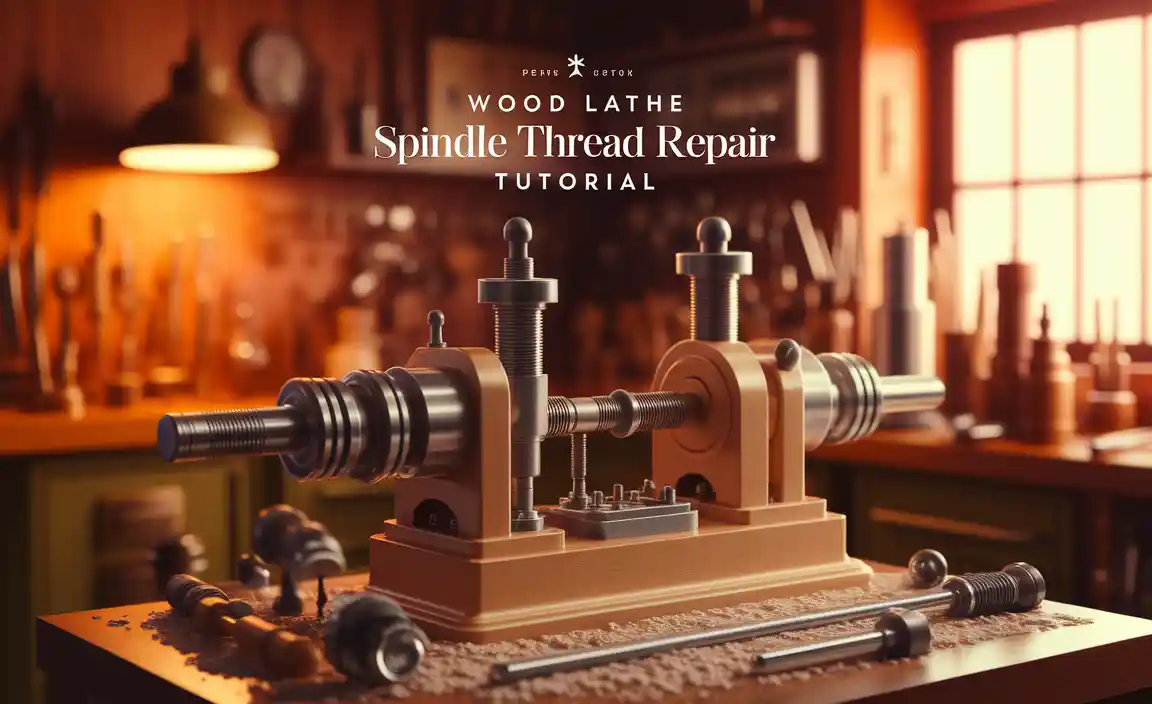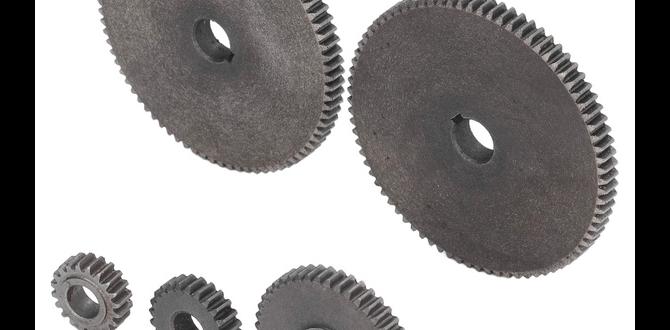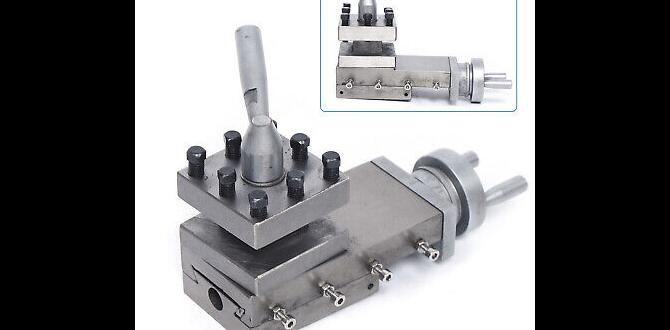A 1/8 inch carbide end mill with a stub length and 1/4 inch shank, when used correctly, can significantly extend its life when cutting brass, leading to more efficient and cost-effective machining.
Working with brass can be a rewarding experience for any machinist, but it also presents unique challenges. One common frustration is how quickly cutting tools can wear down, especially when using smaller diameter mills. This can lead to poor surface finishes, inaccurate cuts, and lost time and money as you constantly replace worn-out tools. But what if there was a simple, effective way to boost the life of your tools, specifically a 1/8 inch carbide end mill, when tackling brass? You’ve come to the right place. In this guide, we’ll explore exactly that, focusing on practical tips and a proven approach to get the most out of your 1/8 inch carbide end mills. Get ready to discover how to make your brass machining projects smoother and more economical.
Why a 1/8 Inch Carbide End Mill is Great for Brass (and How to Make it Last)
Brass is a fantastic material for hobbyists and professionals alike. It’s relatively soft, easy to machine, and has a beautiful color. However, its tendency to “gum up” or build up chips on the cutting edges of tools can be a real headache. This build-up is a primary reason why tool life can be shorter than you’d expect, especially with smaller diameter tools like a 1/8 inch end mill. These tiny cutters have very delicate edges, and brass’s sticky nature can quickly dull them, turning a precise cut into a rough mess.
Carbide is a superior material for cutting tools compared to High-Speed Steel (HSS) because it’s much harder and can withstand higher temperatures. This means it can cut faster and stay sharp longer. Pairing the hardness of carbide with the precision of a 1/8 inch end mill is a great combination for working with brass. However, even the best carbide tool needs a little help to reach its full potential, especially in a material like brass. We’re going to dive into specific strategies that will help your 1/8 inch carbide end mill last significantly longer.
Understanding the 1/8 Inch Carbide End Mill for Brass
When we talk about a 1/8 inch carbide end mill for brass, we’re usually looking at a tool designed for fine detail work. The smaller diameter is perfect for creating intricate features, text, or small pockets. For brass, a few key characteristics of the end mill itself can make a big difference:
Material Matters: Why Carbide is King
Carbide, or tungsten carbide, is a ceramic compound that is incredibly hard and brittle. This hardness allows it to maintain a sharp cutting edge much longer than other tool materials. It also has a higher melting point, meaning it can handle the heat generated during machining without softening. For brass, where chip welding can be an issue, carbide’s ability to resist this and stay sharp is paramount.
The 1/8 Inch Diameter: Precision and Limitations
A 1/8 inch end mill offers fantastic precision. It’s ideal for engraving, small slotting, and creating fine details. However, this small size also means the cutting edges are very fine and have less structural support than larger tools. They are more susceptible to chipping or breaking if subjected to excessive force or improper machining parameters. This is where choosing the right type of 1/8 inch end mill becomes crucial.
Stub Length and 1/4 Inch Shank for Brass
For brass machining, especially with smaller end mills, look for a “stub length” end mill. This means the flute length (the part with the cutting edges) is shorter relative to the diameter than a standard end mill. A shorter flute length offers more rigidity, which reduces vibration and the likelihood of the tool deflecting or breaking. This added rigidity is a huge benefit when cutting slightly gummy materials like brass.
Coupled with a 1/4 inch shank, this provides a good balance of rigidity and accessibility for most smaller milling machine collets or tool holders. A 1/4 inch shank is substantial enough to provide good clamping force without being overly large for a 1/8 inch cutting diameter. This combination is often specifically designed for materials like brass and aluminum, aiming for longer tool life.
Key Factors for Extending End Mill Life in Brass
Simply having the right tool isn’t enough. How you use it is just as important, if not more so, when cutting brass. Here are the critical factors to consider:
1. Cutting Feed Rate and Speed
This is arguably the most important factor. Brass can be machined at relatively high speeds, but there’s a sweet spot. Too fast, and you’ll generate excessive heat and chip welding. Too slow, and you’ll rub the material, again generating heat and dulling the edge.
- Spindle Speed (RPM): For a 1/8 inch carbide end mill in brass, a good starting point is often between 10,000 and 20,000 RPM. The exact speed depends on the specific alloy of brass, the rigidity of your machine, and the type of cut you’re making.
- Feed Rate (IPM or mm/min): This determines how fast the tool moves through the material. A common mistake is feeding too slowly, which causes rubbing. For brass, you want a feed rate that allows the tool to take a clean chip. A good starting point for chip load (the thickness of material removed by each cutting edge) is around 0.001 to 0.002 inches per tooth. To calculate feed rate: Feed Rate = Chip Load Number of Flutes Spindle Speed. So, for a 2-flute end mill at 15,000 RPM with a 0.0015 inch chip load: 0.0015 2 15000 = 45 IPM. Always start conservatively and listen to the cut.
Important Note: Refer to manufacturer recommendations for your specific end mill. Many excellent resources, like the Precision Metalforming Association, offer general machining data that can be a good starting reference.
2. Depth of Cut and Stepover
How much material you remove with each pass is crucial for managing heat and tool load.
- Depth of Cut (DOC): For a 1/8 inch end mill, it’s generally best to keep the depth of cut shallow when cutting all the way through. A common guideline for slotting in brass with carbide is to keep the DOC no more than the diameter of the end mill (0.125 inches). For pockets, you can often go deeper, but it’s wise to break it down into multiple passes. For example, to mill a 1/4 inch deep pocket, take two passes of 0.125 inches each.
- Stepover: This is the amount the end mill moves sideways for each pass when milling a larger area. For effective material removal and to avoid overloading a single edge, a stepover of 20-50% of the tool diameter is typical. For finer finishes, you can decrease this.
3. Coolant or Lubrication
While brass is softer than steel, using a cutting fluid or lubricant is still highly recommended, especially for extended machining times or when taking heavier cuts. Lubrication:
- Reduces friction and heat.
- Helps to flush chips away from the cutting zone.
- Prevents chip welding onto the tool.
- Improves surface finish.
For brass, aerosol spray lubricants (like those with a sulfur base, although some prefer to avoid sulfurized oils for aesthetic reasons on brass), or a light flood coolant mist are excellent choices. A simple trick for small jobs is using a few drops of cutting oil or even WD-40, applied strategically.
4. Chip Evacuation
Brass produces relatively small, sometimes stringy chips. If these chips aren’t cleared from the flute, they can recut, causing friction, heat, and premature tool wear. This is where the stub length and appropriate speeds/feeds come into play, but also:
- Air Blast: A directed stream of compressed air can help blow chips out of the cut.
- Through-Spindle Coolant (if available): This is the most effective method, directing coolant and air directly into the flutes.
- Peck Drilling Cycles (for pockets): If milling a deep pocket, a “peck” or “chip break” cycle where the cutter retracts slightly periodically helps clear chips.
5. Tool Rigidity and Machine Condition
A wobbly machine or a loose tool holder is the enemy of any cutting tool. For small end mills:
- Ensure your collet is clean and gripping the shank tightly.
- Check for any runout (wobble) in your spindle. Excessive runout will cause uneven cutting and premature wear.
- Make sure your machine’s ways are properly lubricated and there’s no excessive play.
A rigid setup means the tool can perform its job without being constantly knocked around, which is vital for the delicate edges of a 1/8 inch end mill.
Choosing the Right 1/8 Inch Carbide End Mill for Brass
Not all 1/8 inch carbide end mills are created equal. For brass, consider these features:
Number of Flutes
For softer, gummy materials like brass, fewer flutes are generally preferred. This leaves more space in the flute for chip evacuation.
- 2-Flute: Often the best choice for brass. It provides good chip clearance and is less prone to chip packing than 3 or 4-flute end mills.
- 3-Flute: Can be used for brass but requires careful attention to chip load and lubrication to avoid packing. It offers a smoother finish than a 2-flute in some applications.
- 4-Flute: Generally not recommended for brass unless doing light finishing passes or if your machine has excellent coolant and chip clearing.
Coating
While not always necessary for brass, some coatings can offer additional heat resistance and lubricity which can further boost tool life.
- Uncoated: Perfectly adequate for many brass applications, especially with good lubrication.
- TiN (Titanium Nitride): A common, cost-effective coating that adds hardness and reduces friction.
- ZrN (Zirconium Nitride): Often performs well on non-ferrous materials like brass due to its lubricity and lower affinity for chip welding.
Edge Preparation
Some high-quality end mills come with a slight radius or chamfer on the cutting edge. This “edge prep” can significantly improve tool life by strengthening the edge and making it less prone to chipping. For brass, a small radius is often beneficial.
Step-by-Step Guide: Maximizing Your 1/8 Inch Carbide End Mill in Brass
Let’s put it all together with a practical, step-by-step approach.
Scenario: You need to mill a 1/4 inch wide, 0.100 inch deep slot in a piece of C360 brass using a 1/8 inch 2-flute stub length carbide end mill with a 1/4 inch shank.
- Prepare Your Machine:
- Ensure the milling machine is clean, lubricated, and stable.
- Install a clean collet into the spindle and securely insert the 1/8 inch end mill.
- Check for spindle runout if your machine has this capability. Minimal runout is essential.
- Secure Your Workpiece:
- Firmly clamp your brass workpiece to the milling machine table. Ensure it won’t move during machining.
- Set Up for the Cut:
- Tool Selection: Use a 1/8 inch, 2-flute, stub length carbide end mill. For this example, we’ll assume it’s uncoated.
- Spindle Speed: Set your spindle to 15,000 RPM.
- Feed Rate Calculation: Aiming for a chip load of 0.0015 inches/tooth: Feed Rate = 0.0015 inches/tooth × 2 flutes × 15,000 RPM = 45 IPM. Start here.
- Depth of Cut: Since our brass is 0.100 inch thick and our end mill is 0.125 inch diameter, we can likely take this in one pass if the machine is rigid. However, for maximum tool life and best practice, let’s plan for two passes: 0.050 inches each.
- Stepover: For slotting, the stepover is the width of the slot divided by the diameter of the end mill, unless you’re using adaptive clearing. In this case, we are milling a 0.250 inch slot with a 0.125 inch end mill. This means we will need multiple passes to cut the slot width. We can mill a 0.125 inch diameter slot in the center first, then offset to cut the remaining width. A common strategy is to mill a full-width pocket. For a 0.250 slot, with a 0.125 end mill, a good approach is to machine two full width passes, offsetting by the end mill diameter, or more efficiently, using a toolpath that steps over. For a simple slot, let’s plan on milling a 0.100 deep slot by offsetting our passes. A 50% stepover for the width would be 0.0625″, meaning we would need 4 passes to cover the 0.250″ width. It’s more efficient to do a full slotting operation first.
- Apply Lubrication:
- Start the spindle.
- Apply a mist or drops of cutting fluid to the cutting area as soon as the spindle reaches speed.
- Execute the Cut:
- First Pass (Depth): Move the end mill down to 0.050 inches into the brass. Feed the tool into the material at 45 IPM. Listen for any struggling sounds. If the machine or tool sounds strained, reduce the feed rate. For slotting across the width, maintain the feed.
- Subsequent Passes (Depth): For the second pass, move the tool down to 0.100 inches. Continue feeding at 45 IPM across the programmed path for the slot.
- Chip Evacuation: Monitor chip flow. If chips seem to be packing, slightly increase the air blast or the feed rate momentarily if the machine can handle it without bogging down.
- After the Cut:
- Once the cut is complete, retract the spindle and stop the spindle.
- Carefully remove the workpiece.
- Inspect the tool for any signs of chip welding or excessive wear. Clean the tool and the machine.
This method emphasizes controlled cuts, proper speeds and feeds, and lubrication to ensure your 1/8 inch carbide end mill performs optimally and lasts longer.
Comparing Tooling Options
It’s always good to understand your options. Here’s a quick comparison focusing on what impacts tool life when machining brass with a 1/8 inch tool.
| Tooling Aspect | Benefit for Brass Tool Life | Considerations |
|---|---|---|
| 1/8″ Carbide End Mill (Stub Length, 1/4″ Shank) | High hardness resists wear; stub length adds rigidity; 1/4″ shank provides good clamping. Excellent all-around for precision and durability. | Can be brittle if overloaded; requires precise parameters; higher initial cost than HSS/plastic. |
| 1/8″ HSS End Mill | Lower cost. Less prone to catastrophic fracture than carbide. | Softer, dulls much faster in brass; heats up quickly; poor chip welding resistance; can result in a rough finish. |
| 1/8″ High-Performance Carbide (e.g., Z-Coated, specific brass alloys) | Optimized coatings and geometries for non-ferrous materials can offer even longer life and better finishes. Example: A tool with a specific zirconium nitride (ZrN) coating. | Higher cost. Performance gain might be marginal for very light hobbyist use but significant for production runs. |
| Plastic or Specialty “Brass Cutting” End Mills (e.g., specialized polymers) | Extremely low friction and heat generation; no chip welding. Can provide excellent surface finishes. | Not suitable for heavy material removal; can wear quickly if pushed; limited depth of cut. Often used for engraving or very light profiling. |
For the best balance of durability, precision, and affordability for general brass machining






